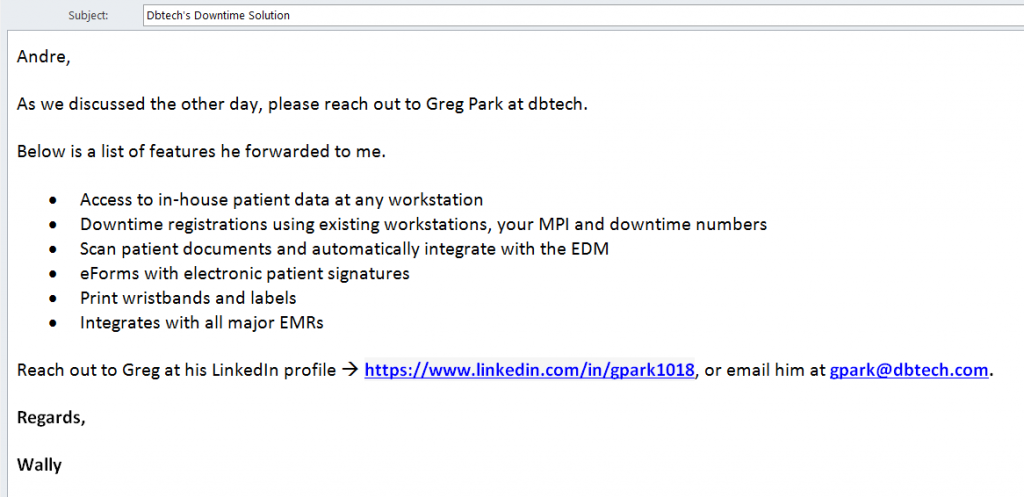
 Andre could see sickness wash over Wally’s face as he asked, “How much did we pay for our EMR?”
Andre could see sickness wash over Wally’s face as he asked, “How much did we pay for our EMR?”
Wally was hired as CIO to help Mercy Hospital prepare for their epic EMR implementation. Their vendor selection was safe yet contentious and ruled by typical political tribes. Soon after the decision disgruntled employees would hurl this vendor’s name from their mouths like a 4 letter word.
“Go ask Mitch in AP! He knows how much is spent on everything!” Wally followed with a chuckle to buy time and craft a response.
Wally in an air of secrecy lifted his hand to his mouth and confessed, “We signed the contract for 80 million, but after staff education, re-aligning projects, bringing on consultants and allocating funds for a million and one little things, our bottom-line was well over 100 million. I know…I know…it’s inconceivable.” Wally words were heavy like something both necessary and awful.
Andre was stunned. He imagined all the ways 100 million could be used, including modernizing dated diagnostic and surgical equipment or acquiring that struggling hospital down the road (if you were to believe the hospital rumor mill).
Andre was a lifer at Mercy Hospital and was recently promoted to Director of Patient Intake. He was a catalyst, known for asking politically explosive questions in committee meetings and social gatherings.
Andre and Wally sat in the cafeteria that late afternoon, without their lunch bunch of directors, c-suites and other lifers. Andre knew his moment was here, “Ok, with all the cash spent and all the time invested in installing this EMR, how come my staff is following the same downtime procedures as 15 years ago? Last week’s downtime was scheduled for 4 hours starting at midnight, but we were down for 16 hours. Now I know this wasn’t your fault, but I want you to know Wally that I’m uncomfortable our ability to handle long downtimes, especially unplanned ones. Can we handle downtimes like what happened to HCA? You remember the blowback they received from the press when their EMR was down for 3 days?”
“What I mean to say Wally is shouldn’t we do a better job preparing for downtimes? Andre and Wally were work-friends, but Andre’s words struck Wally like a gauntlet across the face.
Andre continued his siege, “None of us at first realized the EMR would go down every 6 weeks. I mean, it’s a pain to my staff, but fortunately it’s happening overnight. When it happens we use downtime numbers and paper registration forms, just like we have for the last 15 years. Wally, I haven’t given you this report yet, but our QA process is finding a significant number of transcription errors between the paper registration forms and re-keying that data back into the EMR. It’s a big problem.”
“Also, none of us realized the document management and forms platforms would also be offline at the same time as the EMR. So not only is my staff hand-keying registration data, but they also are photocopying insurance cards, driver’s licenses and other forms only to re-scan into the document management platform later!”
“Wally, you remember that situation the other week with the patient on 2 South? I’m sure medications were delayed because the barcode on the patient’s wristband didn’t jive with the order. I’ll take responsibility for that, but it happened because my staff doesn’t have a good way of generating forms during downtimes. We avoided a big problem, this time.” Andre lost his cool over things he couldn’t control but knew how to fix.
“How long of a downtime can we take?” asked Andre.
Wally sensed Andre had been practicing his lines like a nervous actor preparing for an audition.
Wally in an uncharacteristically contrite tone replied, “Andre thanks for speaking to me about this in private. Your timing is really good. I have been chatting with an old IT colleague, and he and his developers have created something that will address all of this and then some.”
“I agree with you Andre. We should have paid more attention to downtime, but it’s not too late to address it now. Andre, do you know that my IT guys are printing out reports right before downtime? It’s practically a whole case of paper because it contains every in-house patient and every iota of clinical data we can fit. Our nurse stations and clinical areas use this report to access patient data during downtime. It’s a limited solution because it can’t be shared by lots of people. We tried to share the report on a network drive, but we lost control. People were copying the file, printing it out and leaving PHI trails all over the place. Also, we know it won’t work when the network goes down.”
“My friend’s company has created a way to capture this same exact data and publish to numerous workstations. They are building their business case on both downtime registration tools and providing secure access to patient data during EMR AND Network downtimes.
“Andre, you know patient care is my primary concern, but second is our bottom line. Just last week, Joe on the board forwarded a study from Thomson Reuters that estimated an increase of $266 per minute during downtimes, which is insane!” Wally words felt like a confession.
Andre was ignited. “Wally, let me be a part of any committee you form on this. I’ll do all the research and categorize the benefits. Just send me this LinkedIn contact and I will do the rest.”
Wally agreed, and a few days later Andre received an email that read…

If you would like more information about dbtech’s Downtime Solution, please follow this link!